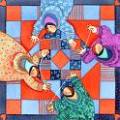
Quilting Reviews
|
Sewing Tips For Beginning Quilters
Sewing Tips For Beginning Quilters
Sewing by hand, or with a needle and thread is the traditional method used to piece together quilt blocks. Even if you own a sewing machine you should practice these stitches. Remember to choose the smallest size needle that you can comfortably work with. Be sure that you are using special quilting thread. Quilting thread is thicker, more durable and doesn't tangle. Cut a piece of quilting thread about to feet long. Thread the needle and place a single knot in the end of the thread with a short tail to prevent unraveling. Do not double the thread. Sew with one single strand.
Place the two quilt pieces that you are connecting together, with right sides facing each other. Pin them using three pins. Place one pin in each of the top two corners, and the third pin in the middle of the piece. Begin at one corner and poke the needle through both layers of fabric then bring it up through the fabric about 1/8th of an inch down the seam line. Take one backstitch to keep your end secure, and then continue this in and out stitching. This is a running stitch, also called a piecing stitch. It takes practice to get a straight line. You may draw a line in pencil on the wrong side of the fabric if this helps. Once you have reached the other corner take a backstitch in reverse and make a 90-degree turn into the seam allowance. Make to stitches and cut the thread. Many quilters do not knot the ends of their thread, as they feel knots rub and wear out the material faster.
Another stitch that beginners should learn is the appliqué stitch. In appliqués blocks a fabric motif is cut out, layered and stitched onto the background of another fabric. This method of sewing the layers together needs to be almost invisible to the eye. The appliqué stitch should leave a small visible dot of a stitch. To begin, start with a quilting needle and knotted quilting thread in a color that blends with the appliqué motif. Prepare the design by basting the raw edges under. Pressing with the tip of an iron first will help. Next baste the fabric motif onto the background fabric in the desired position.
Now it's finally time to appliqué. Start by placing the needle under the background fabric. Push the needle up through the background fabric and the edge of the appliqué motif. Pull the thread through both layers. Now position the needle right next to where the thread comes up, but only on the background fabric. Make an1/8th inch stitch through the background fabric and bring it up at the edge of the appliqué motif. Continue this stitch all around the fabric motif, ending underneath the background fabric on the wrong side. Knot and trim.
Hand sewing seems like a very time consuming process. Once you develop a rhythm, it proceeds much faster. Hand sewn quilts are often prized over machine-stitched creations.
 |
 |
 |
Add Life To Your Quilting With Embroidery
How To Choose The Right Batting
More Quilting Articles
... What Are Quilts? Quilts are bed coverings made up of three layers: a quilt top, a layer of batting, and a layer of material for backing. The layers are usually combined using the technique of quilting. Quilting is the process of using a needle and thread to combine two or more layers of cloth. This step ...
Quilting Is A Hot D.I.Y. Craft
... the burgeoning interest in quilting and other crafts coincided with the development of the computer. High tech, high touch, the saying goes. When we are surrounded with technology all day we long for tactile satisfaction. Fibers such as wool and cotton have become very popular because of this, and also ...
... give step-by-step instructions, to books which will take one aspect of quilting and explain how to do it. The instructional books start with such basics as fabric selection and which tools you'll need and proceed through instructions for assembling the blocks of the quilt top and the quilt itself, down ...
... necessary. Accuracy is important in quilting. Taking the time to cut accurately will ensure your quilt pieces fit together perfectly. Marking tools should be tested before you use them. You want the marks to come out easily without damaging the material. Special quilter's pencils are available with white ...

|
| Copyright © 2006-2012 Internet Marketing Tools, All Rights Reserved |